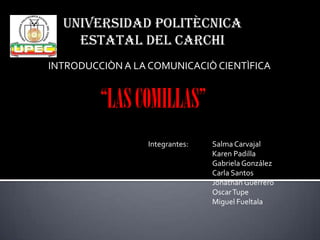Diapositivas
•Descargar como PPTX, PDF•
0 recomendaciones•901 vistas
Este documento habla sobre el uso de las comillas en la comunicación científica. Explica que las comillas se usan para citar textualmente palabras de otra persona y para indicar títulos de artículos, capítulos de libros o poemas. También señala seis usos específicos de las comillas como marcar apodos, palabras no comunes o dar un sentido irónico a las palabras entrecomilladas.
Denunciar
Compartir
Denunciar
Compartir

Recomendados
Recomendados
Más contenido relacionado
Destacado
Destacado (20)
Product Design Trends in 2024 | Teenage Engineerings

Product Design Trends in 2024 | Teenage Engineerings
How Race, Age and Gender Shape Attitudes Towards Mental Health

How Race, Age and Gender Shape Attitudes Towards Mental Health
AI Trends in Creative Operations 2024 by Artwork Flow.pdf

AI Trends in Creative Operations 2024 by Artwork Flow.pdf
Content Methodology: A Best Practices Report (Webinar)

Content Methodology: A Best Practices Report (Webinar)
How to Prepare For a Successful Job Search for 2024

How to Prepare For a Successful Job Search for 2024
Social Media Marketing Trends 2024 // The Global Indie Insights

Social Media Marketing Trends 2024 // The Global Indie Insights
Trends In Paid Search: Navigating The Digital Landscape In 2024

Trends In Paid Search: Navigating The Digital Landscape In 2024
5 Public speaking tips from TED - Visualized summary

5 Public speaking tips from TED - Visualized summary
Google's Just Not That Into You: Understanding Core Updates & Search Intent

Google's Just Not That Into You: Understanding Core Updates & Search Intent
The six step guide to practical project management

The six step guide to practical project management
Beginners Guide to TikTok for Search - Rachel Pearson - We are Tilt __ Bright...

Beginners Guide to TikTok for Search - Rachel Pearson - We are Tilt __ Bright...
Diapositivas
- 1. UNIVERSIDAD POLITÈCNICA ESTATAL DEL CARCHI INTRODUCCIÒN A LA COMUNICACIÒ CIENTÌFICA “LAS COMILLAS” Integrantes: Salma Carvajal Karen Padilla Gabriela González Carla Santos Jonathan Guerrero Oscar Tupe Miguel Fueltala
- 2. USO DE LAS COMILLAS Cuando se elaboran textos, el uso de las comillas para referenciar fuentes externas protege contra el plagio y representan también honestidad académica. Las comillas forman parte del grupo de los signos de puntuación que se usan en el español.
- 3. TIPOS DE COMILLAS Comillas simples.-Se utilizan, en obras de carácter lingüístico, para enmarcar el Comillas dobles.- Su uso no es significado de un universal. Algunos manuales de término: estilo (particularmente ingleses, como el de Oxford) prefieren las comillas simples ”Papá”
- 4. LAS COMILLAS DEBEN USARSE PARA 1. Para indicar que se citan textualmente las palabras de otra persona. “La imaginación es la voz de los atrevidos”. Henry Miller 2. Para indicar el título de artículos dentro de publicaciones periódicas, o capítulos específicos dentro de libros, o poemas dentro de poemarios.
- 5. 3. Para destacar el título de un libro o de una obra que aparece dentro del título de otro libro. Cómo leer “Don Quijote de la Mancha” 4. Para sobrenombres o apodos que acompañan o sustituyen al nombre de una persona. Lope de Vega, “El Fénix de los Ingenios”
- 6. 5. Para señalar el uso intencionado de alguna palabra no común, como en el caso de vulgarismos, neologismos o eufemismos. 6. Para dar un sentido irónico a las palabras entre ellas. Ello significa que lo entrecomillado debe interpretarse exactamente al revés.